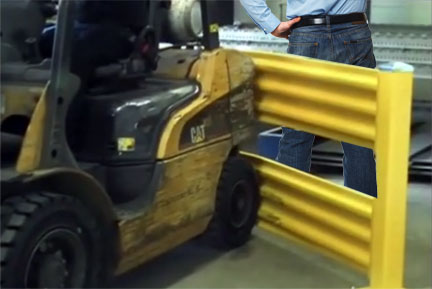Guard Rail: When, Where and What
Exploring guard rail types and what they are used for

Choosing guard rail can be confusing unless you understand clearly what kinds of conditions you are protecting against and what assets you are protecting. Whether it be fall protection for workers or asset protection from industrial vehicle usage, there is a guard rail that fits that need.
Fall Protection
OSHA has very specific requirements for fall protection. Basically those standards are: 1) guard rail must be placed in any location where a fall of more than 6 ft. is possible, 2) the top height of railing must be at least 42″ tall, plus or minus 3″, 3) the railing must be able to withstand a minimum of 200 lbs. side and top loaded pressure with a maximum deflection of no more than 3″, 4) a mid rail or mesh panel must fill the space between the mounting surface and the top rail, 5) the top rail must be a minimum of .25″ diameter so as to not cut or abrade workers’ hands. For the complete OSHA requirements, go to: More OSHA Requirements.
Asset Protection
The standards for asset protection are much looser with critical factors focusing on employee protection, therefore many of the standards used in fall protection apply in asset protection. Areas you would want to protect might be pallet rack aisle ends, conveyors, pedestrian aisles, building walls, work stations, electrical/utility panels and controls, HVAC equipment, in-plant offices, and mezzanines.
Comparisons
Guard Rail Types |
Impact Capacity |
Construction Type |
Applications |
|
| Hand Rail | Minimum of 200 lbs. top or side loaded | Usually tubular steel; some flexible poly | Fall protection: mezzanines, dock ramps, uneven floor levels
Asset protection: pedestrian aisles |
|
| Pipe Rail | Forklifts and industrial vehicles | Schedule 40 steel 6″-8″ pipe rails;
Schedule 80 steel posts |
Single rail: Asset protection for machines, walls, conveyor;
Double rail: Asset protection for traffic aisles, pedestrian walkways, utility panels, in-plant offices |
|
| Flexible Poly Rail | Forklifts and industrial vehicles | 8″ Polymer Tubing rails, 4″ steel posts | Asset protection: walls, machines, conveyor, pedestrian walkways, work stations utility panels, in-plant offices | |
| Light Duty Steel | Pallet trucks and light industrial vehicles | 14 gauge corrugated high strength steel rails, 6″ structural flange beam posts | Single rail: Asset protection for conveyor, rack ends, walls
Double & triple rail: Asset protection for traffic aisles, pedestrian walkways, work stations utility panels, in-plant offices |
|
| Drop-In Lift-Out Rail | Up to 5,000 lbs. | 14 gauge W-shape high tensile strength steel rails, 4″ steel posts | Single rail: Asset protection for conveyor, rack ends, walls
Double rail: Asset protection for traffic aisles, pedestrian walkways, utility panels, in-plant offices |
|
| Medium Duty Steel | Fork truck and industrial vehicle impact | 11 gauge double rib steel rails, 3″ structural steel posts | Single rail: Asset protection for conveyor, rack end, walls
Triple rail: Asset protection for traffic aisles, pedestrian walkways, utility panels, in-plant offices |
|
| Heavy Duty Steel | Forklift and industrial vehicle impact | 11 gauge high strength corrugated steel rails, 4″ structural steel square tube posts | Single rail: Asset protection for conveyor, rack end, wall
Double rail: Asset protection for traffic aisles, pedestrian walkways, utility panels, in-plant offices |
What the comparisons tell you
While many types of guard rail appear very similar, the primary differences are the grade of steel and other materials used in construction. That difference adds up to how many times the rail can withstand impact before deforming or damaging the anchor points and needing to be replaced. One advantage of the polymer based guard rail is the ability to deflect and dissipate the impact forces, leading to additional resiliency in the long run. All guard rail will fail if impacted enough times. What you want to consider is long-term cost efficiencies and risk factors for the particular locations you are installing guard rail at.
The long and short of it
Take a good look at the why of installing guard rail, the impact probabilities, and damage/injury risk you’re protecting against. Those should be your primary determinants in choosing a particular guard rail system. After all, achieving optimum safety is what you’re after, right?
Tags: hand rail, guarding systems, warehouse safety, Safety & Ergonomics, guard rail
Scott Stone is Cisco-Eagle's Vice President of Marketing with 35 years of experience in material handling, warehousing and industrial operations. His work is published in multiple industry journals an websites on a variety of warehousing topics. He writes about automation, warehousing, safety, manufacturing and other areas of concern for industrial operations and those who operate them.



